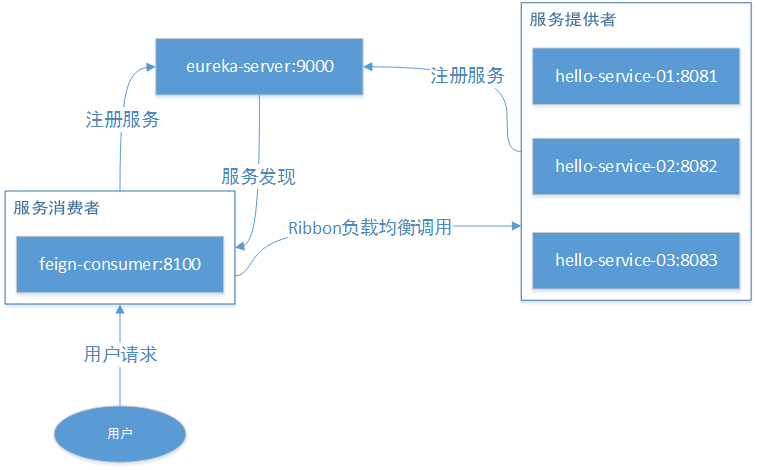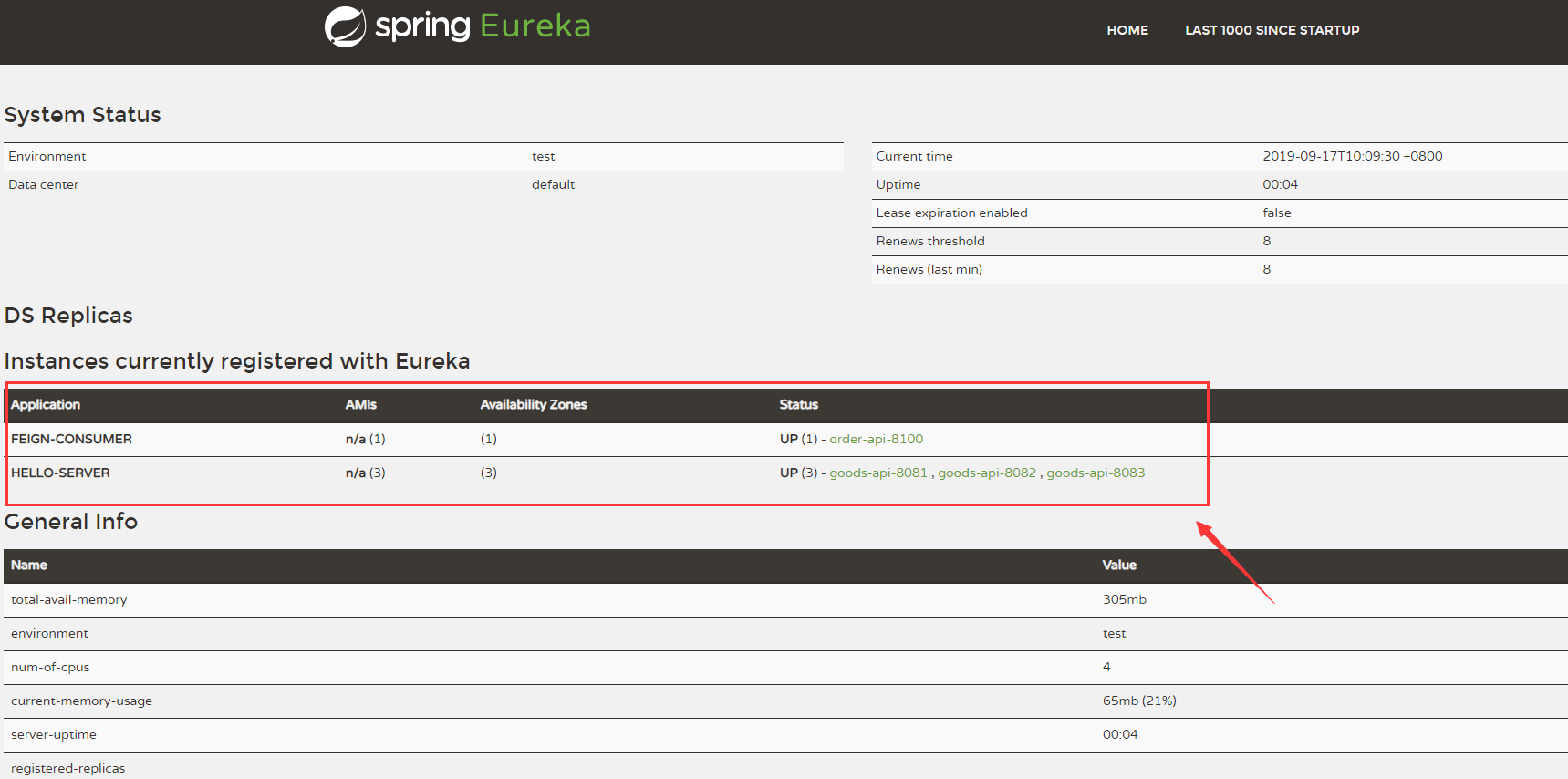Spring Cloud Eureka 分散式開發之服務註冊中心、負載均衡、宣告式服務呼叫實現

介紹
本示例主要介紹 Spring Cloud 系列中的 Eureka,使你能快速上手負載均衡、宣告式服務、服務註冊中心等
Eureka Server
Eureka 是 Netflix 的子模組,它是一個基於 REST 的服務,用於定位服務,以實現雲端中間層服務發現和故障轉移。
服務註冊和發現對於微服務架構而言,是非常重要的。有了服務發現和註冊,只需要使用服務的識別符號就可以訪問到服務,而不需要修改服務呼叫的配置檔案。該功能類似於 Dubbo 的註冊中心,比如 Zookeeper。
Eureka 採用了 CS 的設計架構。Eureka Server 作為服務註冊功能的服務端,它是服務註冊中心。而系統中其他微服務則使用 Eureka 的客戶端連線到 Eureka Server 並維持心跳連線
Eureka Server 提供服務的註冊服務。各個服務節點啟動後會在 Eureka Server 中註冊服務,Eureka Server 中的服務登錄檔會儲存所有可用的服務節點資訊。
Eureka Client 是一個 Java 客戶端,用於簡化 Eureka Server 的互動,客戶端同時也具備一個內建的、使用輪詢負載演算法的負載均衡器。在應用啟動後,向 Eureka Server 傳送心跳(預設週期 30 秒)。如果 Eureka Server 在多個心跳週期內沒有接收到某個節點的心跳,Eureka Server 會從服務登錄檔中將該服務節點資訊移除。
簡單理解:各個微服務將自己的資訊註冊到server上,需要呼叫的時候從server中獲取到其他微服務資訊
Ribbon
Spring Cloud Ribbon 是基於 Netflix Ribbon 實現的一套客戶端負載均衡工具,其主要功能是提供客戶端的軟體負載均衡演算法,將 Netflix 的中間層服務連線在一起。
Ribbon 提供多種負載均衡策略:如輪詢、隨機、響應時間加權等。
Feign
Feign是宣告式、模板化的HTTP客戶端,可以更加快捷優雅的呼叫HTTP API。在部分場景下和Ribbon類似,都是進行資料的請求處理,但是在請求引數使用實體類的時候顯然更加方便,同時還支援安全性、授權控制等。
Feign是集成了Ribbon的,也就是說如果引入了Feign,那麼Ribbon的功能也能使用,比如修改負載均衡策略等
程式碼實現
1.建立eureka-server服務註冊中心
pom.xml pom配置
<?xml version="1.0" encoding="UTF-8"?>
<project xmlns="http://maven.apache.org/POM/4.0.0" xmlns:xsi="http://www.w3.org/2001/XMLSchema-instance"
xsi:schemaLocation="http://maven.apache.org/POM/4.0.0 http://maven.apache.org/xsd/maven-4.0.0.xsd">
<modelVersion>4.0.0</modelVersion>
<groupId>com.easy</groupId>
<artifactId>eureka-server</artifactId>
<version>0.0.1-SNAPSHOT</version>
<packaging>jar</packaging>
<name>eureka-server</name>
<description>Demo project for Spring Boot</description>
<parent>
<artifactId>cloud-feign</artifactId>
<groupId>com.easy</groupId>
<version>1.0.0</version>
</parent>
<dependencies>
<dependency>
<groupId>org.springframework.cloud</groupId>
<artifactId>spring-cloud-starter-netflix-eureka-server</artifactId>
</dependency>
<dependency>
<groupId>org.springframework.boot</groupId>
<artifactId>spring-boot-starter-test</artifactId>
<scope>test</scope>
</dependency>
</dependencies>
<build>
<plugins>
<plugin>
<groupId>org.springframework.boot</groupId>
<artifactId>spring-boot-maven-plugin</artifactId>
</plugin>
</plugins>
</build>
</project>
application.yml 配置檔案
server:
port: 9000
spring:
application:
name: eureka-server
eureka:
instance:
hostname: localhost # eureka 例項名稱
client:
register-with-eureka: false # 不向註冊中心註冊自己
fetch-registry: false # 是否檢索服務
service-url:
defaultZone: http://${eureka.instance.hostname}:${server.port}/eureka/ # 註冊中心訪問地址EurekaServerApplication.java 啟動類
package com.easy.eurekaServer;
import org.springframework.boot.SpringApplication;
import org.springframework.boot.autoconfigure.SpringBootApplication;
import org.springframework.cloud.netflix.eureka.server.EnableEurekaServer;
@EnableEurekaServer
@SpringBootApplication
public class EurekaServerApplication {
public static void main(String[] args) {
SpringApplication.run(EurekaServerApplication.class, args);
}
}
2.建立hello-service-api介面
Result.java 統一返回實體
package com.easy.helloServiceApi.vo;
import lombok.Getter;
import java.io.Serializable;
@Getter
public class Result implements Serializable {
private static final long serialVersionUID = -8143412915723961070L;
private int code;
private String msg;
private Object data;
private Result() {
}
private Result(int code, String msg) {
this.code = code;
this.msg = msg;
}
private Result(int code, String msg, Object data) {
this.code = code;
this.msg = msg;
this.data = data;
}
public static Result success() {
return success(null);
}
public static Result success(Object data) {
return new Result(200, "success", data);
}
public static Result fail() {
return fail(500, "fail");
}
public static Result fail(int code, String message) {
return new Result(code, message);
}
}
Order.java 訂單實體類
package com.easy.helloServiceApi.model;
import lombok.AllArgsConstructor;
import lombok.Data;
import lombok.NoArgsConstructor;
/**
* 訂單類
*/
@Data
@NoArgsConstructor
@AllArgsConstructor
public class Order {
private String orderId;
private String goodsId;
private int num;
}GoodsServiceClient.java 宣告商品服務類
package com.easy.helloServiceApi.client;
import com.easy.helloServiceApi.vo.Result;
import org.springframework.cloud.openfeign.FeignClient;
import org.springframework.web.bind.annotation.PathVariable;
import org.springframework.web.bind.annotation.RequestMapping;
@FeignClient(value = "hello-server")
public interface GoodsServiceClient {
@RequestMapping("/goods/goodsInfo/{goodsId}")
Result goodsInfo(@PathVariable("goodsId") String goodsId);
}Goods.java商品實體類
package com.easy.helloServiceApi.model;
import lombok.AllArgsConstructor;
import lombok.Data;
import lombok.NoArgsConstructor;
import lombok.ToString;
/**
* 商品類
*/
@Data
@NoArgsConstructor
@AllArgsConstructor
@ToString
public class Goods {
private String goodsId;
private String name;
private String descr;
// 測試埠
private int port;
}
3.建立hello-service-01服務提供者(這裡建立三個一樣的服務提供者做負載均衡用)
GoodsController.java商品服務入口
package com.easy.helloService.controller;
import com.easy.helloService.service.GoodsService;
import com.easy.helloServiceApi.model.Goods;
import com.easy.helloServiceApi.vo.Result;
import org.springframework.beans.factory.annotation.Autowired;
import org.springframework.web.bind.annotation.PathVariable;
import org.springframework.web.bind.annotation.RequestMapping;
import org.springframework.web.bind.annotation.RestController;
@RestController
@RequestMapping("/goods")
public class GoodsController {
@Autowired
private GoodsService goodsService;
@RequestMapping("/goodsInfo/{goodsId}")
public Result goodsInfo(@PathVariable String goodsId) {
Goods goods = this.goodsService.findGoodsById(goodsId);
return Result.success(goods);
}
}
GoodsService.java介面
package com.easy.helloService.service;
import com.easy.helloServiceApi.model.Goods;
public interface GoodsService {
Goods findGoodsById(String goodsId);
}
GoodsServiceImpl.java實現介面
package com.easy.helloService.service.impl;
import com.easy.helloService.service.GoodsService;
import com.easy.helloServiceApi.model.Goods;
import org.springframework.stereotype.Service;
import java.util.HashMap;
import java.util.Map;
@Service
public class GoodsServiceImpl implements GoodsService {
// 模擬資料庫
private static Map<String, Goods> data;
static {
data = new HashMap<>();
data.put("1", new Goods("1", "華為", "華為手機", 8081)); //表示呼叫8081埠的資料,實際上資料會放在資料庫或快取中
data.put("2", new Goods("2", "蘋果", "蘋果", 8081));
}
@Override
public Goods findGoodsById(String goodsId) {
return data.get(goodsId);
}
}
HelloServiceApplication.java啟動類
package com.easy.helloService;
import org.springframework.boot.SpringApplication;
import org.springframework.boot.autoconfigure.SpringBootApplication;
import org.springframework.cloud.client.discovery.EnableDiscoveryClient;
@EnableDiscoveryClient
@SpringBootApplication
public class HelloServiceApplication {
public static void main(String[] args) {
SpringApplication.run(HelloServiceApplication.class, args);
}
}application.yml配置檔案,8081埠做01服務
server:
port: 8081
spring:
application:
name: hello-server
eureka:
instance:
instance-id: goods-api-8081
prefer-ip-address: true # 訪問路徑可以顯示 IP
client:
service-url:
defaultZone: http://localhost:9000/eureka/ # 註冊中心訪問地址4.建立hello-service-02服務提供者(貼出和01服務不一樣的地方)
application.yml配置檔案,8082做02服務埠
server:
port: 8082
spring:
application:
name: hello-server
eureka:
instance:
instance-id: goods-api-8082
prefer-ip-address: true # 訪問路徑可以顯示 IP
client:
service-url:
defaultZone: http://localhost:9000/eureka/ # 註冊中心訪問地址GoodsServiceImpl.java 這裡故意設定不同的資料來源,用來測試負載均衡有沒生效使用
package com.easy.helloService.service.impl;
import com.easy.helloService.service.GoodsService;
import com.easy.helloServiceApi.model.Goods;
import org.springframework.stereotype.Service;
import java.util.HashMap;
import java.util.Map;
@Service
public class GoodsServiceImpl implements GoodsService {
// 模擬資料庫
private static Map<String, Goods> data;
static {
data = new HashMap<>();
data.put("1", new Goods("1", "華為", "華為手機", 8082)); //表示8082埠的資料,實際上資料會放在資料庫或快取中
data.put("2", new Goods("2", "蘋果", "蘋果", 8082));
}
@Override
public Goods findGoodsById(String goodsId) {
return data.get(goodsId);
}
}
5.建立hello-service-02服務提供者(貼出和01服務不一樣的地方)
application.yml配置檔案,8082做02服務埠
server:
port: 8083
spring:
application:
name: hello-server
eureka:
instance:
instance-id: goods-api-8083
prefer-ip-address: true # 訪問路徑可以顯示 IP
client:
service-url:
defaultZone: http://localhost:9000/eureka/ # 註冊中心訪問地址GoodsServiceImpl.java 這裡故意設定不同的資料來源,用來測試負載均衡有沒生效使用
package com.easy.helloService.service.impl;
import com.easy.helloService.service.GoodsService;
import com.easy.helloServiceApi.model.Goods;
import org.springframework.stereotype.Service;
import java.util.HashMap;
import java.util.Map;
@Service
public class GoodsServiceImpl implements GoodsService {
// 模擬資料庫
private static Map<String, Goods> data;
static {
data = new HashMap<>();
data.put("1", new Goods("1", "華為", "華為手機", 8083)); //表示8083埠的資料,實際上資料會放在資料庫或快取中
data.put("2", new Goods("2", "蘋果", "蘋果", 8083));
}
@Override
public Goods findGoodsById(String goodsId) {
return data.get(goodsId);
}
}
6.建立feign-consumer服務消費者,引入Ribbon實現服務呼叫負載均衡並實現宣告式服務呼叫
pom.xml配置
<?xml version="1.0" encoding="UTF-8"?>
<project xmlns="http://maven.apache.org/POM/4.0.0" xmlns:xsi="http://www.w3.org/2001/XMLSchema-instance"
xsi:schemaLocation="http://maven.apache.org/POM/4.0.0 http://maven.apache.org/xsd/maven-4.0.0.xsd">
<modelVersion>4.0.0</modelVersion>
<groupId>com.easy</groupId>
<artifactId>feign-consumer</artifactId>
<version>0.0.1-SNAPSHOT</version>
<packaging>war</packaging>
<name>feign-consumer</name>
<description>Demo project for Spring Boot</description>
<parent>
<artifactId>cloud-feign</artifactId>
<groupId>com.easy</groupId>
<version>1.0.0</version>
</parent>
<dependencies>
<!-- springmvc -->
<dependency>
<groupId>org.springframework.boot</groupId>
<artifactId>spring-boot-starter-web</artifactId>
</dependency>
<!-- eureka 客戶端 -->
<dependency>
<groupId>org.springframework.cloud</groupId>
<artifactId>spring-cloud-starter-netflix-eureka-client</artifactId>
</dependency>
<!-- ribbon -->
<dependency>
<groupId>org.springframework.cloud</groupId>
<artifactId>spring-cloud-starter-netflix-ribbon</artifactId>
</dependency>
<!-- feign -->
<dependency>
<groupId>org.springframework.cloud</groupId>
<artifactId>spring-cloud-starter-openfeign</artifactId>
</dependency>
<dependency>
<groupId>org.apache.commons</groupId>
<artifactId>commons-lang3</artifactId>
<version>3.9</version>
</dependency>
<dependency>
<groupId>org.springframework.boot</groupId>
<artifactId>spring-boot-starter-test</artifactId>
<scope>test</scope>
</dependency>
<dependency>
<groupId>com.easy</groupId>
<artifactId>hello-service-api</artifactId>
<version>0.0.1</version>
</dependency>
</dependencies>
<build>
<plugins>
<plugin>
<groupId>org.springframework.boot</groupId>
<artifactId>spring-boot-maven-plugin</artifactId>
</plugin>
</plugins>
</build>
</project>
引入openfeign、ribbon、eureka-client等依賴,openfeign用來實現宣告式服務呼叫,ribbon用來實現負載均衡,eureka-client用來註冊、發現服務
RestConfiguration.java 配置
package com.easy.feignConsumer.config;
import com.netflix.loadbalancer.IRule;
import com.netflix.loadbalancer.RandomRule;
import org.springframework.cloud.client.loadbalancer.LoadBalanced;
import org.springframework.context.annotation.Bean;
import org.springframework.context.annotation.Configuration;
import org.springframework.web.client.RestTemplate;
@Configuration
public class RestConfiguration {
@Bean
@LoadBalanced
public RestTemplate getRestTemplate() {
return new RestTemplate();
}
/**
* 隨機選取負載均衡策略
* @return
*/
@Bean
public IRule testRule() {
return new RandomRule();
}
}GoodsService 服務類介面
package com.easy.feignConsumer.service;
import com.easy.helloServiceApi.model.Goods;
import com.easy.helloServiceApi.vo.Result;
public interface GoodsService {
Result placeGoods(Goods goods);
}GoodsServiceImpl.java 實現類
package com.easy.feignConsumer.service.impl;
import com.easy.feignConsumer.service.GoodsService;
import com.easy.helloServiceApi.client.GoodsServiceClient;
import com.easy.helloServiceApi.model.Goods;
import com.easy.helloServiceApi.vo.Result;
import lombok.extern.slf4j.Slf4j;
import org.apache.commons.lang3.builder.ToStringBuilder;
import org.springframework.beans.factory.annotation.Autowired;
import org.springframework.stereotype.Service;
@Service
@Slf4j
public class GoodsServiceImpl implements GoodsService {
@Autowired
private GoodsServiceClient goodsServiceClient;
@Override
public Result placeGoods(Goods order) {
Result result = this.goodsServiceClient.goodsInfo(order.getGoodsId());
if (result != null && result.getCode() == 200) {
log.info("=====獲取本地商品====");
log.info("介面返回資料為==>{}", ToStringBuilder.reflectionToString(result.getData()));
}
return result;
}
}
GoodsController.java 控制器
package com.easy.feignConsumer.controller;
import com.easy.feignConsumer.service.GoodsService;
import com.easy.helloServiceApi.model.Goods;
import com.easy.helloServiceApi.vo.Result;
import org.springframework.beans.factory.annotation.Autowired;
import org.springframework.web.bind.annotation.RequestMapping;
import org.springframework.web.bind.annotation.RestController;
@RestController
@RequestMapping("/goods")
public class GoodsController {
@Autowired
private GoodsService orderService;
@RequestMapping("/place")
public Result placeGoods(Goods goods) {
Result result = this.orderService.placeGoods(goods);
return result;
}
}FeignConsumerApplication.java 訊息者啟動類
package com.easy.feignConsumer;
import org.springframework.boot.SpringApplication;
import org.springframework.boot.autoconfigure.SpringBootApplication;
import org.springframework.cloud.netflix.eureka.EnableEurekaClient;
import org.springframework.cloud.openfeign.EnableFeignClients;
@EnableFeignClients(basePackages = {"com.easy"})
@EnableEurekaClient
@SpringBootApplication
public class FeignConsumerApplication {
public static void main(String[] args) {
SpringApplication.run(FeignConsumerApplication.class, args);
}
}application.yml 配置檔案
server:
port: 8100
spring:
application:
name: feign-consumer
eureka:
instance:
instance-id: order-api-8100
prefer-ip-address: true # 訪問路徑可以顯示 IP
client:
service-url:
defaultZone: http://localhost:9000/eureka/ # 註冊中心訪問地址使用示例
執行建立的5個服務
1個服務註冊中心,3個服務提供者,1個服務消費者
進入服務註冊中心檢視服務
位址列輸入:http://localhost:9000/,我們看到5個服務註冊成功並且都是執行狀態了(UP狀態),效果如下:

- Application列下有兩個服務(FEIGN-CONSUMER、HELLO-SERVER)
- Availability Zones列下表示可用服務分別的數量(這裡分別顯示1和3)
- Status 列顯示服務狀態,UP表示服務在執行狀態,後面分別跟著服務的內部地址:goods-api-8100(服務消費者),goods-api-8081(服務提供者01), goods-api-8082(服務提供者02), goods-api-8083(服務提供者03)
呼叫介面測試
位址列輸入:http://localhost:8100/goods/place?goodsId=1,返回資料結果為:
{
code: 200,
msg: "success",
data: {
goodsId: "1",
name: "華為",
descr: "華為手機",
port: 8081
}
}- 多重新整理幾次頁面,我們發現port會在8081 8082 8083隨機變化,表示我們的隨機負載均衡器生效了
- 隨意關掉2個或1個服務提供者,重新整理頁面介面功能無影響,能正常返回資料,實現了高可用
宣告式服務和非宣告式服務對比
非宣告式服務呼叫程式碼
@Test
public void testFeignConsumer() {
Goods goods = new Goods();
goods.setGoodsId("1");
Result result = this.restTemplate.getForObject("http://HELLO-SERVER/goods/goodsInfo/" + goods.getGoodsId(), Result.class);
log.info("成功呼叫了服務,返回結果==>{}", ToStringBuilder.reflectionToString(result));
}消費端每個請求方法中都需要拼接請求服務的 URL 地址,存在硬編碼問題並且這樣並不符合面向物件程式設計的思想
宣告式服務呼叫
@FeignClient(value = "hello-server")
public interface GoodsServiceClient {
@RequestMapping("/goods/goodsInfo/{goodsId}")
Result goodsInfo(@PathVariable("goodsId") String goodsId);
} @Autowired
private GoodsServiceClient goodsServiceClient;
@Override
public Result placeGoods(Goods order) {
Result result = this.goodsServiceClient.goodsInfo(order.getGoodsId());
return result;
}通過編寫簡單的介面和插入註解,就可以定義好HTTP請求的引數、格式、地址等資訊,實現遠端介面呼叫,這樣將使我們的程式碼更易擴充套件和利用,複合面向物件程式設計實現。
資料
- Spring Cloud Feign 示例原始碼
- 參考資料
- 官方資料
